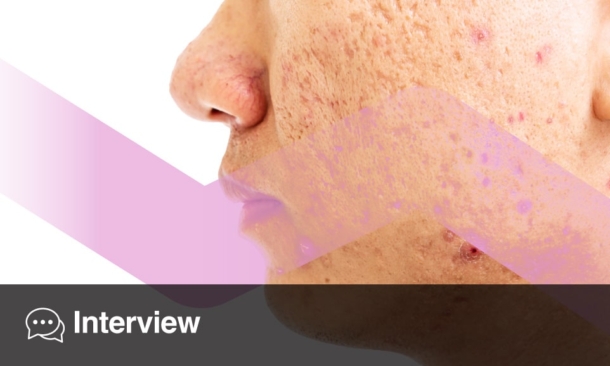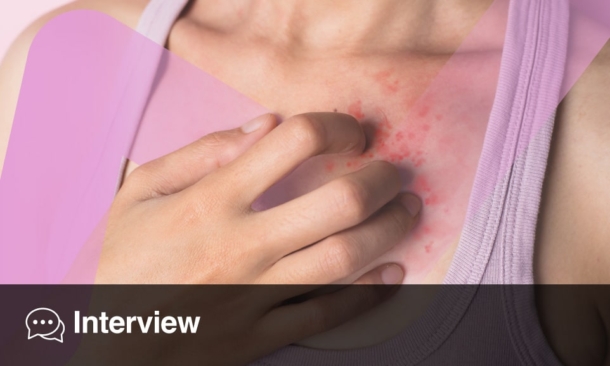Author: Victoria Antoniou, EMJ, London, UK
Citation: EMJ Dermatol. 2024;12[1]:23-26. https://doi.org/10.33590/emjdermatol/VVLD8338.
![]()
Thomas Bieber, University of Bonn, Germany, wasted no time in welcoming his colleagues from around the world to the fascinating session entitled ‘New and Emerging Drugs’, one of many insightful lectures at this year’s European Academy of Dermatology and Venereology (EADV) Congress 2024, taking place in Amsterdam, the Netherlands, from 25th–28th September. The session covered the latest drug developments in classical chronic inflammatory skin disorders, from psoriasis to vitiligo, with some of the world’s leading experts in their respective areas taking to the stage to discuss current and future treatments.
HIDRADENITIS SUPPURATIVA
“We’re at a great time in hidradenitis, where drugs that are being tested are really helping us to understand this incredibly complex disease,” began James Krueger, Rockefeller University, New York, USA, as he opened his talk on hidradenitis suppurativa (HS). HS is an immunological problem that spans innate and adaptive immune mechanisms with contributions from skin-based cytokines and which also likely involves bacterial dysbiosis. Compared to the other inflammatory diseases discussed in the same session, which generally have just one immune axis, HS is a much more complex disease, argued Krueger.
Explaining the background of this difficult-to-treat disorder, Krueger pointed out that HS is a disease spectrum. Researchers in the field believe that it begins with bacterial growth in hair follicles, follicular plugging, and eventually swelling and inflammation of hair follicles with the potential to rupture. There is additionally inflammation of the interfollicular epidermis, involving both T cells and other immune cells, as well as the activation of specific cytokine pathways. As the disease progresses, nodules and ostia develop, along with scarring. The clinical scoring of this aspect of HS is the inflammatory nodule count and/or the abscess count from the basis of the Hidradenitis Suppurativa Clinical Response (HiSCR) tool (50% reduction in nodule + abscess count). The approval of adalimumab, secukinumab, and bimekizumab has been based on HiSCR, implicating TNF and IL-17 isoforms in abscess development. Beyond HiSCR, tunnel inflammation is captured in draining tunnel count and International Hidradenitis Suppurativa Severity Score System (ISH4) score, though the latter is not accepted by the FDA, as the speaker clarified.
Krueger went on to discuss the many drugs in development that focus on IL-17 targeting. This is a vital part of psoriasis treatment, and using this approach with HS has revealed that IL-17A and IL-17F are major cytokines involved in HS disease activity. As a result of these findings, several drugs have been developed and approved: secukinumab (anti-IL-17) received FDA approval in 2023; positive Phase III studies of bimekizumab in HS have been reported, leading to EU approval; a positive Phase II study of sonelokimab has been presented; and positive results of isokibep were also announced at EADV 2024. Going into further detail, Krueger described how a significantly higher proportion of participants receiving sonelokimab achieved HiSCR 50 versus those receiving a placebo at Week 12.1 Additionally, in this trial, 14.9% of patients receiving sonelokimab attained 100% improvement in inflammatory nodules.
Other research has tested the efficacy of dual IL-1α/β monoclonal antibody in treating HS, and further early studies thus far appear to support the role of B cells in active inflammation, as treatment with spleen tyrosine kinase and Bruton’s tyrosine kinase inhibitors (remibrutinib) have shown disease improvement.2
The numerous trials currently underway, along with the recent drug approvals, demonstrate that, though HS is a complex disease, the future looks bright when it comes to the treatment of people with HS.
ATOPIC DERMATITIS
Current treatment methods for atopic dermatitis (AD) are standardised and very simple across European practices; topical on the one hand, including steroids and topical calcineurin inhibitors (TCI), and systemic on the other, divided into small molecules such as baricitinib, and biologics, such as dupilumab. Bieber, Chair of this session and expert in AD treatment, took his colleagues through the various treatment methods currently available, discussing the drugs available in Europe as well as the ones he fears will not be permitted in the EU any time soon.
Moving on to the future of the disease, Bieber briefly described the highly complex pathogenesis of AD, relating to both skin barrier dysfunction and immune response.3 This complexity has led to the current development of a very large number of drugs; there are at least 33 different kinds of biologics alone under development, highlighted Bieber. This is being done using the classical drug development approach from recent years, or what Bieber labelled the ‘downstream approach’, involving targeting T2 cytokines. Dupilumab, tralokinumab, and the ‘new kid on the block’, the recently approved lebrikizumab, are all developed in this way.
According to Bieber, despite the continued innovation happening in the field, the majority of the most innovative drugs developed for the topical treatment of AD, which are often available in the USA, for example, ruxolitinib or PDE4 inhibitors, will likely never be available in the EU for treatment of AD. This is a result of several factors, including the restrictions of Health Technology Assessment Agencies (HTA) and market access issues. This is not, however, a reason to lose faith in the future of AD treatment. The always-evolving understanding of the pathophysiology of the disease has led to a recent revolution in drug development, not only for AD but for a whole host of inflammatory conditions. Moreover, many of these drugs are being developed with a focus on disease modification, aiming for long-term control for patients, which marks a shift from the previous focus on treating flares and controlling the condition by staying on therapy.Though there will never, at least in Bieber’s opinion, be a one-size-fits-all solution for the treatment of AD, the shift in drug development strategy as well as the change in mindset amongst researchers and those involved in this development means that, in the years to come, the lives of patients with inflammatory diseases have the potential to improve significantly.
ALOPECIA AREATA AND VITILIGO
Though on the surface, a disease characterised by hair loss and another by complete skin depigmentation may not appear to have many similarities, they are not as unconnected as they may appear. Julien Seneschal, University of Bordeaux, France, took to the stage as the third of four speakers to discuss the two diseases. He explained that several studies have reported associations between the conditions,4-8 and that they both share several underlying genes, mainly associated with the immune system. Additionally, when analysing the cells, researchers have found that the area around the hair follicle of a patient with alopecia areata (AA) contains several T cells, which are also found in the melanated areas of the skin in patients with vitiligo. In both diseases, these T cells are interacting with epithelial cells, meaning that the two disorders share many similarities.
Addressing the new treatments on the horizon for each disease, Seneschal first brought to light a Phase IIa study conducted in 2022, in which 40 patients with AA were prescribed dupilumab while 20 were given a placebo for 24 weeks.9 The team involved in this research found that dupilumab worked best in patients with AA with high IgE levels. Today, several more Phase II studies are underway, each targeting a different protein, including further research into the potential of dupilumab for treating AA.
There are also several more studies currently taking place to treat vitiligo, focusing on halting depigmentation, inducing repigmentation, and ideally preventing relapses. One such study being carried out by Seneschal himself involved assessing the use of UV light in combination with baricitinib for the treatment of active vitiligo. Patients received baricitinib or a placebo alongside UV light for 12 weeks, and the yet-to-be-published data showed that though the placebo group showed a small change in their Total Body Vitiligo Area Scoring Index (T-VASI) score (–9.2), there was a significant reduction in T-VASI score amongst the baricitinib group (–44.8) at Week 36. These are promising results, pointed out Seneschal, and offer hope for the future of vitiligo treatment. The same can be said for several of the trials currently underway; however, it is also the change in approach and attitude, as with AD, that proves the most impactful in furthering the development of drugs for these diseases, focusing on earlier intervention and preventing relapses.
PSORIASIS
The final presentation, delivered by Co-chair Antonio Costanzo, Humanitas University of Milan, Italy, closed the session by addressing the new drugs being developed to treat psoriasis, a disease caused by the sequential activation of different components of the immune system. Though many therapeutic options are presently available for psoriasis, unlike some of the other afflictions discussed in the same session, there is always space for more, pointed out Costanzo, highlighting that pharmacological research continues to focus on the disease. Like his colleagues before him, Costanzo took the crown through the mechanism of the disorder and explained the specific ways in which these new drugs hope to target it.
Current trials include looking into new mechanisms of action for the inhibition of key cytokine pathways, and Costanzo expressed hope that the field may soon be able to move away from injectable to oral drugs in the not-too-distant future, given the efficacy of some of the new oral drugs being developed. Further away is the personalisation of psoriasis treatment; as with so many inflammatory diseases, every patient benefits from different treatment approaches, and though it is not yet possible to treat each one differently, he emphasised that it is becoming a priority amongst clinicians.
The presentations delivered during this symposium demonstrated that the future of treatment for these various dermatological conditions is indeed a hopeful one. Though the road to developing these treatments is not a smooth one, and researchers may yet find themselves blocked by country-specific regulations and restrictions that limit their ability to roll out a new drug or challenges when it comes to treating the individual patient. On the whole, the many trials taking place today offer a range of new possibilities for clinicians and patients alike.







